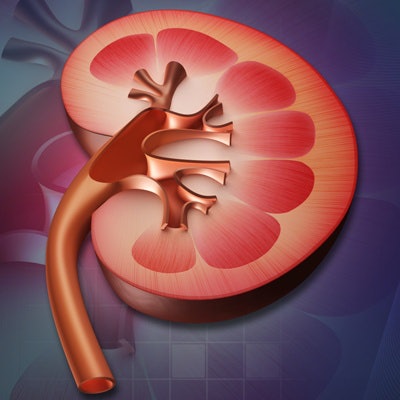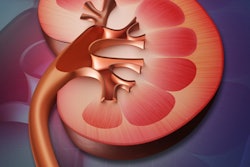
The use of contrast media in x-ray and CT exams is probably less harmful to the kidneys than previously thought, and clinicians should reconsider the wisdom of withholding important imaging exams based on their use of contrast, even in individuals at risk, concludes a just-published study in the Journal of the American Society of Nephrology.
The massive retrospective study of nearly 6 million hospitalized patients in the U.S. found that patients receiving contrast did not develop acute kidney injury (AKI) at a clinically significant higher rate than other patients. In fact, after controlling for patients' health and morbidities, the use of contrast was actually associated with a lower likelihood of developing AKI.
"We show data suggesting that the risk of acute kidney injury related to radiocontrast administration has been overestimated, and we would like for physicians, including cardiologists, radiologists, and surgeons who frequently are faced with decisions regarding the use or nonuse of radiocontrast-enhanced imagining studies, to take this information into account in their clinical decision-making," said Dr. Glenn Chertow from Stanford University School of Medicine in a statement accompanying the study (JASN, September 29, 2016).
Squaring off on causes of kidney injury
Iodinated contrast is required for a variety of CT and x-ray studies, especially of the cardiovascular system, but its use is known to contribute to acute kidney injury. A widely cited 2002 study concluded that contrast is responsible for one-third of all cases of AKI.
There is little agreement about the incidence of AKI, which ranges from 1% to about 30% of patients who receive contrast, according to examples in the literature. Two prospective studies failed to show an increase in acute kidney injury in the presence of contrast.
Yet despite the uncertainty, patients perceived by their doctors to be at increased risk for acute kidney injury -- for example, older individuals or those with underlying chronic kidney disease or diabetes -- are less likely to undergo contrast-enhanced studies. Research that has looked at natural fluctuations in serum creatinine suggests that the published rates of contrast-associated nephropathy may be exaggerated.
Aiming to offer a more accurate estimate of the burden of acute kidney injury among patients receiving radiocontrast, the researchers compared patients receiving contrast with a group with similar morbidity and severity of illness who did not receive contrast during their hospitalization.
"We hypothesized that the risk of AKI in patients who received radiocontrast would not be dramatically different from the risk in patients who did not receive radiocontrast," wrote Stanford's Dr. Emilee Wilhelm-Leen and Maria Montez-Rath, PhD, along with Chertow.
The authors used the Nationwide Inpatient Sample to estimate the risk of contrast-associated nephropathy among patients hospitalized in the U.S. in 2009. The patients were stratified by the presence or absence of 12 fairly common diagnoses associated with AKI and evaluated for the rate of AKI between the various strata.
The 12 disease states analyzed were heart failure exacerbation, chronic obstructive pulmonary disease (COPD) exacerbation, sepsis, pneumonia, urinary tract infection/pyelonephritis, endocarditis, peritonitis, venous thromboembolism including deep venous thrombosis and pulmonary embolism, acute coronary syndrome, stroke or cerebrovascular accident, acute pancreatitis, and gastrointestinal (GI) bleeding, the group wrote.
Covariates included age, sex, the validated Charlson/Elixhauser comorbidity index, and the presence or absence of a procedure code for mechanical ventilation. Patients who were given contrast tended to be older, male, and white. Contrast was more commonly given at teaching hospitals than in other types of facilities.
The data were analyzed using a logistic regression model that controlled for comorbidity and the acuity of illness in order to estimate the risk of AKI associated with contrast administration within the risk strata. An additional analysis stratified the results by degree of pre-existing comorbidity. In all, the team analyzed data from 5,931,523 hospitalizations.
Few differences in kidney injury
"In general, patients who received radiocontrast did not develop AKI at a clinically significant higher rate," the authors wrote.
Overall, patients who received or didn't receive contrast developed AKI at rates of 5.5% and 5.6%, respectively. After controlling for comorbidity and illness severity, contrast administration was associated with an odds ratio for acute kidney injury of 0.93. In most conditions, the risk of AKI differed by only 2% to 3%.
The use of contrast was associated with a significantly higher risk of AKI in a few conditions, notably pneumonia and urinary tract infection/pyelonephritis, considered together. In acute pancreatitis, the risk doubled with use of iodinated contrast.
| Rate of acute kidney injury with and without contrast | |||
| Patient group | AKI %, no contrast | AKI %, with contrast | p-value |
| Entire sample | 5.6 | 5.5 | 0.51 |
| Congestive heart failure exacerbation | 19.0 | 16.6 | < 0.0001 |
| Pneumonia | 12.7 | 16.3 | < 0.0001 |
| Endocarditis | 19.9 | 16.4 | 0.1964 |
| Urinary tract infection/pyelonephritis | 15.7 | 17.4 | 0.0001 |
| Venous thromboembolism | 9.2 | 6.9 | 0.0012 |
| COPD exacerbation | 15.1 | 16.3 | 0.3821 |
| GI bleeding | 13.8 | 16.8 | < 0.0001 |
| Acute pancreatitis | 8.2 | 16.4 | < 0.0001 |
In a dataset containing 6 million hospitalizations and representing 96% of the U.S. population, "our analyses suggest that the incremental risk of AKI that can be attributed to radiocontrast is modest at worst, and almost certainly overestimated by patients, physicians, surgeons, radiologists, and other decision-makers," the authors wrote. "This relation between radiocontrast exposure and AKI varies according to total comorbidity and acuity of illness, and is modified by the presence of specific disease states."
In fact, the risk with and without contrast was identical for most of the population at 5.5% and 5.6%, they noted. And when the data were controlled for demographic features and a validated combined morbidity score, contrast administration was actually associated with a 7% lower risk of AKI. Similarly, the risk is lower for individuals with acute coronary syndrome (ACS) who receive contrast.
Contrast not risk-free
Despite the results, "it is very unlikely that radiocontrast 'protects' patients with ACS from developing AKI," they wrote. "Rather, this paradox could be explained by the fact that patients who are deemed by clinicians to be at highest risk for AKI are treated in such a way as to minimize perceived risk."
Even with pancreatitis, for which the risk doubled with the use of contrast, contrast should not necessarily be blamed, due to the large number of potential comorbidities that are more likely the cause of additional risk in these patients, they noted.
Study strengths include its large, nationally representative population, its use of two separate analyses used to compare two intrinsically different patient groups, and even the consistency of its results, the team wrote. On the limitation side, the diagnostic codes available are less sensitive for the identification of AKI than clinical data, though the overall AKI rates are consistent with other data.
The value gained and the risk incurred by contrast-enhanced studies is a critically important question, but even sophisticated analyses may fail to detect the full effect of patient selection on the results. As a result, clinicians may conclude that there is no risk at all, whether or not it can be determined. Caution is therefore needed when interpreting studies such as this one, and clinicians must carefully weigh the benefits of contrast with the risk, which is "likely low but not zero," the authors concluded.




















